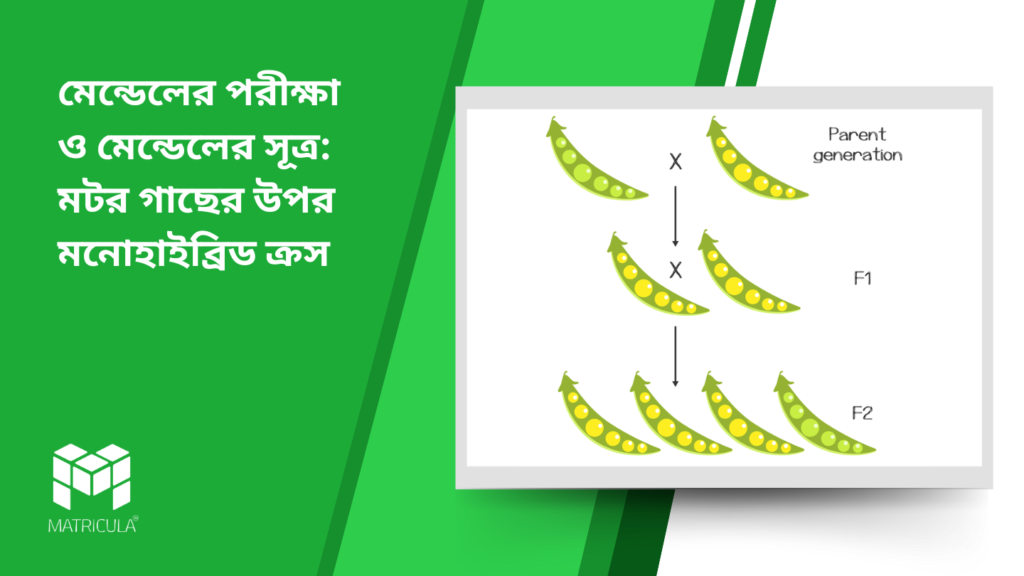Introduction
Heredity is the process through which traits are passed from one generation to the next. Gregor Johann Mendel, known as the “Father of Genetics,” conducted experiments on pea plants (Pisum sativum) to understand the principles of inheritance. His experiments led to the formulation of fundamental genetic laws. This article will discuss Mendel’s monohybrid cross experiment and the laws derived from it.
Mendel’s Experiment on Monohybrid Cross
A monohybrid cross is a genetic cross between two organisms that differ in one specific trait. Mendel selected pea plants due to their distinct characteristics and ease of controlled breeding.
Selection of Pea Plant
Mendel chose the pea plant (Pisum sativum) for his experiments because:
- It has contrasting traits (e.g., tall vs. dwarf, round vs. wrinkled seeds).
- It has a short life cycle and produces many offspring.
- It allows for self-pollination and cross-pollination.
Steps of Mendel’s Monohybrid Cross Experiment
Mendel studied the inheritance of plant height using a monohybrid cross. He followed these steps:
- Selection of Parent Plants (P Generation):
- He selected true-breeding tall (TT) plants and true-breeding dwarf (tt) plants.
- These plants were cross-pollinated.
- Formation of First Filial Generation (F₁ Generation):
- The offspring (F₁ generation) were all tall plants (Tt).
- This showed that the tall trait was dominant, and the dwarf trait was recessive.
- Self-Pollination of F₁ Generation:
- Mendel allowed F₁ plants (Tt) to self-pollinate.
- Formation of Second Filial Generation (F₂ Generation):
- The resulting plants showed a 3:1 ratio of tall to dwarf plants.
- 75% (3 out of 4) were tall (TT or Tt), and 25% (1 out of 4) were dwarf (tt).
Punnett Square Representation of Monohybrid Cross
The genetic outcome of Mendel’s monohybrid cross can be illustrated using a Punnett square:
| Parent Alleles | T (Tall) | t (Dwarf) |
| T (Tall) | TT (Tall) | Tt (Tall) |
| t (Dwarf) | Tt (Tall) | tt (Dwarf) |
- Genotypic Ratio: 1 (TT) : 2 (Tt) : 1 (tt)
- Phenotypic Ratio: 3 Tall : 1 Dwarf
Mendel’s Laws of Inheritance
Based on his experiments, Mendel formulated three fundamental laws:
1. Law of Dominance
- In a pair of contrasting traits, one trait (dominant) expresses itself, while the other (recessive) remains hidden in the F₁ generation.
- Example: In the F₁ generation, all plants were tall (Tt) because tallness (T) is dominant over dwarfness (t).
2. Law of Segregation
- Alleles separate during gamete formation, ensuring that each gamete receives only one allele.
- This explains the reappearance of the dwarf trait (tt) in the F₂ generation.
3. Law of Independent Assortment (Not applicable in monohybrid cross)
- This law states that different traits assort independently. However, it applies to dihybrid crosses, not monohybrid crosses.
Conclusion
Mendel’s monohybrid cross experiment provided insights into genetic inheritance. His findings laid the foundation for modern genetics. The law of dominance and law of segregation explain how traits are inherited from one generation to another. These principles continue to be fundamental in the study of genetics today.
Key Takeaways
✔ Mendel studied pea plants to understand heredity.
✔ Monohybrid cross involves one trait (e.g., plant height).
✔ F₁ generation showed only the dominant trait.
✔ F₂ generation showed a 3:1 phenotypic ratio.
✔ Mendel’s laws explain genetic inheritance.
মেন্ডেলের পরীক্ষা ও মেন্ডেলের সূত্র: মটর গাছের উপর মনোহাইব্রিড ক্রস
ভূমিকা
বংশগতিবিদ্যা (Heredity) হল এমন একটি প্রক্রিয়া যার মাধ্যমে বৈশিষ্ট্যগুলি এক প্রজন্ম থেকে পরবর্তী প্রজন্মে সঞ্চারিত হয়। গ্রেগর জোহান মেন্ডেল (Gregor Johann Mendel), যিনি “আধুনিক জেনেটিক্সের জনক” নামে পরিচিত, মটর গাছ (Pisum sativum) নিয়ে গবেষণা করেন এবং বংশগতির মূলনীতিগুলি আবিষ্কার করেন। এই প্রবন্ধে আমরা মেন্ডেলের মনোহাইব্রিড ক্রস পরীক্ষা এবং তার সূত্রসমূহ নিয়ে বিস্তারিত আলোচনা করব।
মেন্ডেলের মনোহাইব্রিড ক্রস পরীক্ষা
একটি মনোহাইব্রিড ক্রস হল এমন একটি জেনেটিক ক্রস যেখানে দুটি পিতৃগাছ মাত্র একটি বৈশিষ্ট্যের দিক থেকে পার্থক্যযুক্ত হয়। মেন্ডেল তার পরীক্ষার জন্য মটর গাছ নির্বাচন করেন, কারণ:
- এতে বিরোধী বৈশিষ্ট্য ছিল (যেমন, লম্বা বনাম বামন, মসৃণ বনাম কুঁচকানো বীজ)।
- এটি স্বল্প জীবনচক্রের এবং প্রচুর বীজ উৎপন্ন করে।
- এটি স্ব-পরাগায়ন (Self-Pollination) ও পর-পরাগায়ন (Cross-Pollination) করা সহজ।
মেন্ডেলের পরীক্ষার ধাপসমূহ
মেন্ডেল মটর গাছের উচ্চতা (Plant Height) নিয়ে পরীক্ষা করেন। তার গবেষণার ধাপগুলি নিম্নরূপ:
১. মূল পিতৃগাছ নির্বাচন (P Generation)
- তিনি বিশুদ্ধ লম্বা (TT) গাছ এবং বিশুদ্ধ বামন (tt) গাছ বেছে নেন।
- এই দুটি গাছকে পর-পরাগায়নের মাধ্যমে সংকরায়িত করা হয়।
২. প্রথম প্রজন্ম (F₁ Generation) সৃষ্টি
- F₁ প্রজন্মের সব গাছ লম্বা (Tt) হয়।
- এতে বোঝা যায় যে লম্বা বৈশিষ্ট্যটি (T) আধিপত্যশীল (Dominant) এবং বামন বৈশিষ্ট্য (t) গোপন (Recessive)।
৩. F₁ প্রজন্মের স্ব-পরাগায়ন
- মেন্ডেল F₁ প্রজন্মের গাছগুলোকে নিজেদের মধ্যে স্ব-পরাগায়নের সুযোগ দেন।
৪. দ্বিতীয় প্রজন্ম (F₂ Generation) সৃষ্টি
- ফলস্বরূপ, F₂ প্রজন্মে ৩:১ অনুপাতে লম্বা ও বামন গাছ দেখা যায়।
- ৭৫% (৩টির মধ্যে ৩টি) লম্বা (TT বা Tt), এবং ২৫% (১টি) বামন (tt) হয়।
মনোহাইব্রিড ক্রসের পুন্নেট স্কোয়ার (Punnett Square)
মেন্ডেলের পরীক্ষার ফলাফল নিম্নলিখিত ছকে দেখানো হয়েছে:
| পিতৃ উদ্ভিদের জিন (Alleles) | T (লম্বা) | t (বামন) |
| T (লম্বা) | TT (লম্বা) | Tt (লম্বা) |
| t (বামন) | Tt (লম্বা) | tt (বামন) |
- জেনোটাইপিক অনুপাত: ১ (TT) : ২ (Tt) : ১ (tt)
- ফেনোটাইপিক অনুপাত: ৩ লম্বা : ১ বামন
মেন্ডেলের বংশগতির সূত্র
তার গবেষণার ভিত্তিতে, মেন্ডেল তিনটি মূল সূত্র প্রণয়ন করেন:
১. আধিপত্যের সূত্র (Law of Dominance)
- বিপরীত বৈশিষ্ট্যের মধ্যে, একটি বৈশিষ্ট্য (Dominant) প্রকাশ পায়, অন্যটি (Recessive) লুকিয়ে থাকে।
- উদাহরণ: F₁ প্রজন্মে সমস্ত গাছ লম্বা (Tt) হয়, কারণ লম্বা বৈশিষ্ট্যটি (T) আধিপত্যশীল।
২. বিভাজনের সূত্র (Law of Segregation)
- জিনের দুইটি অ্যালিল (Allele) পৃথক হয়ে যায় এবং প্রতিটি গ্যামেটে মাত্র একটি অ্যালিল থাকে।
- এটি ব্যাখ্যা করে যে F₂ প্রজন্মে আবার বামন গাছ (tt) দেখা যায়।
৩. স্বতন্ত্র সমাবেশের সূত্র (Law of Independent Assortment)
- এই সূত্র অনুযায়ী, বিভিন্ন বৈশিষ্ট্য একে অপরের থেকে স্বাধীনভাবে বংশগত হয়। তবে এটি শুধুমাত্র ডাইহাইব্রিড ক্রসের ক্ষেত্রে প্রযোজ্য, মনোহাইব্রিড ক্রসের ক্ষেত্রে নয়।
উপসংহার
মেন্ডেলের মনোহাইব্রিড ক্রস পরীক্ষা বংশগতির মূলনীতি ব্যাখ্যা করতে সহায়ক। তার গবেষণা আধুনিক জেনেটিক্সের ভিত্তি স্থাপন করেছে। আধিপত্যের সূত্র এবং বিভাজনের সূত্র বর্ণনা করে কীভাবে বৈশিষ্ট্য পরবর্তী প্রজন্মে সঞ্চারিত হয়। বর্তমানে জেনেটিক্স চর্চার ক্ষেত্রে মেন্ডেলের সূত্র অত্যন্ত গুরুত্বপূর্ণ।
মূল বক্তব্য
✔ মেন্ডেল মটর গাছ নিয়ে বংশগতির গবেষণা করেন।
✔ মনোহাইব্রিড ক্রসের মাধ্যমে একটি বৈশিষ্ট্যের বংশগতি বোঝানো হয়।
✔ F₁ প্রজন্মে শুধুমাত্র আধিপত্যশীল বৈশিষ্ট্য প্রকাশ পায়।
✔ F₂ প্রজন্মে ৩:১ অনুপাতে লম্বা ও বামন গাছ দেখা যায়।
✔ মেন্ডেলের সূত্র আধুনিক জেনেটিক্সের ভিত্তি গঠন করেছে।




